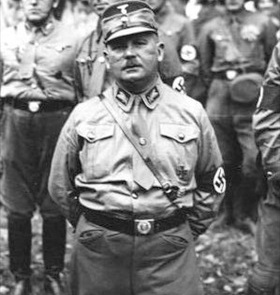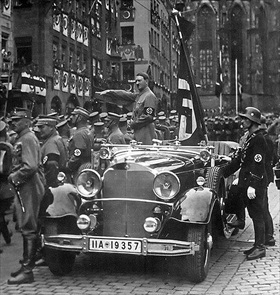GERMAN CAPITAL, OTHER CITIES SCENES OF CARNAGE
Berlin, Germany • June 29, 1934
Late on this date in 1934 German Chancellor Adolf Hitler unleashed an extraordinary murder spree known as the “Night of the Long Knives” (“Nacht der Langen Messer”). President Paul von Hindenburg’s doctors had leaked news that the 86‑year-old German military hero had only months to live. Hitler feared that senior leaders in the Reichswehr (German Army) would push hard for a return of the former Hohenzollern monarchy, which ended with the abdication of Kaiser Wilhelm II following Germany’s defeat in World War I.
Hitler therefore devised a plan to keep the generals from acting against him or his brownshirt thugs, “storm troopers” as they were known, who were members of the Nazi Party’s Sturmabteilung (“Storm Detachment” or “Assault Division”). Known by its abbreviation, the SA was a paramilitary “citizens’ army” led by Hitler’s long-time friend SA-Fuehrer Ernst Roehm, whom the generals saw as commanding a competing force (nearly 3 million strong) to theirs (about 360,000 strong, hamstrung still by limits imposed by the 1919 Versailles peace treaty). Roehm had even floated a harebrained proposal in February 1934 to merge the Reichswehr with his SA, both of course under his command. Rumors of treachery and a coup swirled in the capital’s ether that spring. Hitler, former SA chief Hermann Goering, Reichsfuehrer of the smaller Nazi paramilitary organization known as the Schutzstaffel (Protection Squadron, or SS) Heinrich Himmler, and Deputy Fuehrer Rudolf Hess—all members of the party’s inner circle—could only shudder to think where all this might lead.
And so on this night, “the blackest day of my life” Hitler told 2 army officers on June 29, and extending to July 2, hundreds of mostly SA men were butchered (along with the occasional wife and a smattering of Hitler’s political adversaries); some were dragged out of their beds and shot, while others were killed by firing squads. At least one was hacked to death. Vice-Chancellor Franz von Papen was placed under house arrest. Roehm was disposed of in his prison cell, shot dead by SS officers after refusing to commit suicide. Hitler’s press chief later opined that “the monstrous side of Hitler’s nature for the first time broke loose and showed itself for what it was.” When the purge was complete, Hitler cynically claimed in a speech to the German parliament, the Reichstag, in mid-July that he had saved the nation from a Roehm putsch and ominously that in the future everyone should know that if one raises his hand against the State, then certain death was his lot.
As for saving the country from a coup d’état—chronic falsehood artist Hitler turned truth on its head to his advantage. After the massacre, the army’s old guard, ignorant of the details of the purge, lined up behind the culprit. Even President Hindenburg praised Hitler for taking swift action against the “traitors”—which is what Hitler called his enemies in the Nazi Party. But within Germany and abroad, commentators reacted with amazement and even panic. From his exile in Holland, former Kaiser Wilhelm was deeply appalled by the bloodletting: “What would people have said if I had done such a thing?” he asked. Future Axis partner and Italian strongman Benito Mussolini wrote his sister: “Look at how vicious this man can be! Some terrible names from history come to mind: a new Attila? And he killed some of his closest colleagues.”
“Night of the Long Knives,” June 29 to July 2, 1934: Momentous Milestone on Hitler’s Rise to Power
 |  |
Left: Ernst Roehm in Bavaria in February 1933, 16 months before his murder. Roehm (1887–1934) was one of the earliest members of the Nazi Party and had participated in Hitler’s failed Beer Hall Putsch in late 1923. The “Roehm Putsch” 11 years later was a fiction created by Hitler and his closest associates to win over the Reichswehr, powerful industrialists, aristocrats, landowners, and liberal bourgeoisie who were critical of a national militia with millions of members who engaged in violence and hooliganism. The portly storm troopers’ chief was on record, saying, “There are still men in official positions today who have not the least idea of the spirit of the [Nazi] revolution. We shall ruthlessly get rid of them if they dare to put their reactionary ideas into practice.” (Quoted in Wittman and Kinney, The Devil’s Diary, pp. 234–35.) Roehm’s homosexuality did not endear him to these powerful conservatives, either. In June 1934 their demands that Hitler act against the SA leadership came to grisly fruition. Probably more than 1,000 lost their lives in the well-planned orgy of arrest, assassination, and execution.
![]()
Right: Storm troopers parade past Hitler in Nuremberg, September 1935. Membership in the Sturmabteilung plummeted from 2.9 million in August 1934, a few weeks after Roehm’s murder, to 1.2 million in April 1938. The “Night of the Long Knives”—the term was coined by Hitler himself—represented a triumph for the Nazi leader, as well as a turning point for Germany. It established Hitler as “the supreme judge of the German people,” as he explained to Reichstag members on July 13, 1934. Centuries of German jurisprudence proscribing extrajudicial killings were swept away, replaced by institutionalized violence, chilling brutality, and demonic insanity that distinguished Hitler’s regime until its apocalyptic end in April 1945.
“Night of the Long Knives” Unleashes Horror and Chaos
![]()

 History buffs, there is good news! The Daily Chronicles of World War II is now available as an ebook for $4.99 on Amazon.com. Containing a year’s worth of dated entries from this website, the ebook brings the story of this tumultuous era to life in a compelling, authoritative, and succinct manner. Featuring inventive navigation aids, the ebook enables readers to instantly move forward or backward by month and date to different dated entries. Simple and elegant! Click
History buffs, there is good news! The Daily Chronicles of World War II is now available as an ebook for $4.99 on Amazon.com. Containing a year’s worth of dated entries from this website, the ebook brings the story of this tumultuous era to life in a compelling, authoritative, and succinct manner. Featuring inventive navigation aids, the ebook enables readers to instantly move forward or backward by month and date to different dated entries. Simple and elegant! Click 











